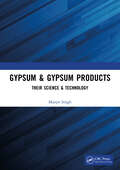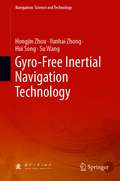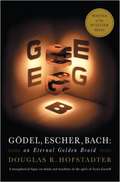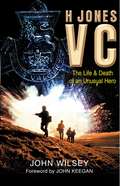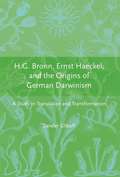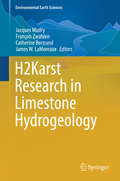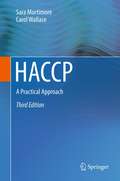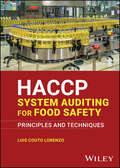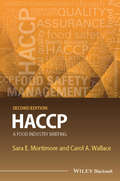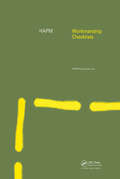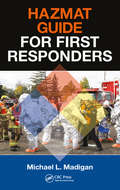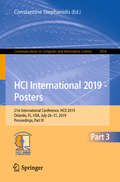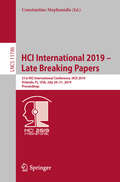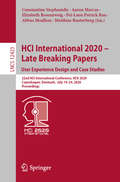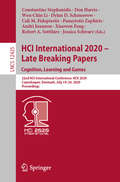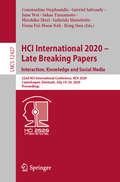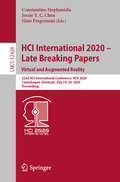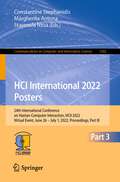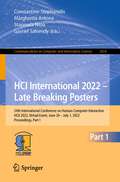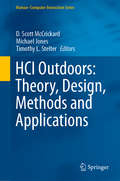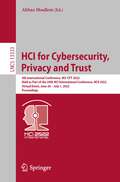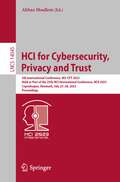- Table View
- List View
Gypsum & Gypsum Products: Their Science & Technology
by Manjit SinghHighly detailed and elaborate, this book is written explicitly for the purpose of professionals who work with gypsum in various technical and consumer-centric fields. It emphasises technical specifications of gypsum and associated products focusing on particular applications in industries such as construction, decoration, medicine, dentistry, architecture, chemical product manufacturing, arts, cooking, cosmetics, and agriculture. The book takes into account different chemical, physical, and biological characteristics and the relevance of gypsum and its extended applications.
Gyro-Free Inertial Navigation Technology (Navigation: Science and Technology #7)
by Hui Song Hongjin Zhou Yunhai Zhong Su WangThis book focuses on gyro-free inertial navigation technology, which is used to measure not only linear motion parameters but also angular rates. Since no gyroscopes are used, the key technologies, such as initial alignment, attitude resolution, and error calibration, are very different than those used in traditional methods.Discussing each key technology in gyro-free inertial navigation system (GFINS) manufacture in a separate chapter, the book features easy-to-understand, detailed illustrations, to allow all those involved in inertial navigation to gain a better grasp of GFINS manufacture, including accelerometer setting principles; initial alignment; quaternion-based, attitude resolution algorithms; and accelerometer de-noise methods.
Gödel, Escher, Bach: An Eternal Golden Braid
by Douglas R. HofstadterThis groundbreaking Pulitzer Prize-winning book sets the standard for interdisciplinary writing, exploring the patterns and symbols in the thinking of mathematician Kurt Gödel, artist M.C. Escher, and composer Johann Sebastian Bach.<P><P> Winner of the National Book Award<P> Pulitzer Prize Winner
H Jones VC: The Life & Death of an Unusual Hero
by John Wilsey'A remarkable book - a worthy tribute both to the man John Wilsey calls "an unusual hero" and to the ethos of the British Army in which he lived and died.' John Keegan in his ForewordThis is the biography of the Falklands War hero whose death in the battle for Darwin and Goose Green was one of the turning points in the whole campaign. It is written with the consent of H Jones's widow, Sara, and is published to coincide with the twentieth anniversary of his death at the climax of the Falklands War. It is the story of an emblematic but complex war hero whose family history was unusual, whose army life included exposure to most of the military problems which Britain has encountered since the Second World War (including security in Northern Ireland, where H Jones was responsible for the search for Robert Nairac), and whose dramatic death and subsequent posthumous VC symbolised an extraordinary campaign which was truly the end of an era.
H-Systems: Observability, Diagnosability, and Predictability of Hybrid Dynamical Systems (Communications and Control Engineering)
by Elena De Santis Maria Domenica Di BenedettoThis book focuses on the observability of hybrid systems. It enables the reader to determine whether and how a hybrid system’s state can be reconstructed from sometimes necessarily partial information. By explaining how available measurements can be used to deduce past and future behaviours of a system, the authors extend this study of observability to embrace the properties of diagnosability and predictability. H-systems shows how continuous and discrete dynamics and their interaction affect the observability of this general class of hybrid systems and demonstrates that hybrid characteristics are not simply generalizations of well-known aspects of traditional dynamics. The authors identify conditions for state reconstruction, prediction and diagnosis of the occurrence of possibly faulty states. The formal approach to proving those properties for hybrid systems is accompanied by simple illustrative examples. For readers who are interested in the use of state estimation for controller design, the book also provides design methods for hybrid state observers and covers their application in some industrial cases. The book’s tutorial approach to the various forms of observability of hybrid systems helps to make H-systems of interest to academic researchers and graduate students working in control and to practitioners using control in an industrial environment.
H. G. Bronn, Ernst Haeckel, and the Origins of German Darwinism: A Study in Translation and Transformation
by Sander GliboffSander tells the story of how The Origin of Species came to be translated into German, how it served Bronn's purposes as well as Darwin's, and how it challenged German scholars to think in new ways about morphology, systematics, paleontology.
H2Karst Research in Limestone Hydrogeology
by James W. Lamoreaux Jacques Mudry François Zwahlen Catherine BertrandChapters in this book are contributions from the 9th Conference on limestone hydrogeology, organized in Besançon in September 2011 selected by the scientific committee of H2Karst. The book presents latest results on in the field of groundwater flow and storage within the different subsystems of karst aquifers; insights into the complex interaction between groundwater and surface water in karst areas by a multidisciplinary approach; current knowledge on contamination problems and contaminant transport in karst aquifers as well as an overview of karst hydrogeology in different contexts around the world.
HACCP
by Carol Wallace Sara MortimoreHACCP: A Practical Approach, 3rd edition has been updated to include the current best practice and new developments in HACCP application since the last edition was published in 1998. This book is intended to be a compendium of up-to-date thinking and best practice approaches to the development, implementation, and maintenance of HACCP programs for food safety management. Introductory chapters set the scene and update the reader on developments on HACCP over the last 15 years. The preliminary stages of HACCP, including preparation and planning and system design, are covered first, followed by a consideration of food safety hazards and their control. Prerequisite program coverage has been significantly expanded in this new edition reflecting its development as a key support system for HACCP. The HACCP plan development and verification and maintenance chapters have also been substantially updated to reflect current practice and a new chapter on application within the food supply chain has been added. Appendices provide a new set of case studies of practical HACCP application plus two new case studies looking at lessons learned through food safety incident investigation. Pathogen profiles have also been updated by experts to provide an up-to-date summary of pathogen growth and survival characteristics that will be useful to HACCP teams. The book is written both for those who are developing HACCP systems for the first time and for those who need to update, refresh and strengthen their existing systems. New materials and new tools to assist the HACCP team have been provided and the current situation on issues that are still undergoing international debate, such as operational prerequisite programs. All tools such as decision trees and record-keeping formats are provided to be of assistance and are not obligatory to successful HACCP. Readers are guided to choose those that are relevant to their situations and which they find are helpful in their HACCP endeavors.
HACCP System Auditing for Food Safety: Principles and Techniques
by Luis Couto LorenzoGuide to understand the fundamentals of HACCP and to planning and conducting food safety audits HACCP System Auditing for Food Safety helps readers understand the fundamentals of the HACCP concept and its importance in ensuring food safety, with guidance on how to develop auditing skills including planning, executing, and reporting on HACCP audits effectively. To aid in reader comprehension, this book incorporates many practical examples with accompanying figures and models, along with selected case studies and global practices from Europe, Canada, USA, and New Zealand to showcase international practices and standards. ISO 19011 as a standard reference is used throughout the text. Written by a seasoned industry professional with decades of hands-on experience as an official control agent, HACCP System Auditing for Food Safety includes information on: Elements of the HACCP methodology, including related concepts, adapted to the specificities of the food operatorPhases of HACCP study and application of the seven principles, respecting their internal logic and how they are interrelatedHACCP as a management system, starting from the commitment of the management or the company’s board of directors, with tasks and responsibilities distributed among staffManagement system auditing techniques to verify performance, whether for internal audits, supplier audits, or certification purposes Providing the rational and scientific basis necessary to anticipate problems and to learn from the experiences and situations that arise in the food industry, HACCP System Auditing for Food Safety is an essential reference for various industry professionals, including technicians, quality managers, consultants, auditors, and official control agents.
HACCP: A Food Industry Briefing
by Sara E. Mortimore Carol A. WallaceReaders of this accessible book – now in a revised and updated new edition – are taken on a conceptual journey which passes every milestone and important feature of the HACCP landscape at a pace which is comfortable and productive. The information and ideas contained in the book will enable food industry managers and executives to take their new-found knowledge into the workplace for use in the development and implementation of HACCP systems appropriate for their products and manufacturing processes. The material is structured so that the reader can quickly assimilate the essentials of the topic. Clearly presented, this HACCP briefing includes checklists, bullet points, flow charts, schematic diagrams for quick reference, and at the start of each section the authors have provided useful key points summary boxes. HACCP: a Food Industry Briefing is an introductory-level text for readers who are unfamiliar with the subject either because they have never come across it or because they need to be reminded. The book will also make a valuable addition to material used in staff training and is an excellent core text for HACCP courses.
HAPM Component Life Manual
by Hapm Publications Ltd.This publication breaks new ground. It is the first document to provide extensive life-span assessments (for insurance purposes) for a wide range of building components which are classified within the concept of quality specifications. A further benefit is that it does not seek to be prescriptive. It indicative 'benchmarks' against which new or differing specifications can be assessed, in that sense it is both robust and flexible.
HAPM Workmanship Checklists
by Construction Audit Ltd.The HAPM Workmanship Checklists fills an important gap in the current information provision in the industry, providing guidance for those engaged in site inspections during the course of building works. Its unique checklist format, designed for use on site, is complimented by extensive references to sources of guidance, standards and legislative in
HAZMAT Guide for First Responders
by Michael L. MadiganThe goal of this book is to help train hazmat response teams and other responders in disaster training, techniques, and planning.The book will also help define and sharpen training plans and assumptions. Focusing on lessons learned from real-world experiences during actual disasters, the book will help to establish a well-trained professional 1st responder, individuals, and teams. Such lessons are emphasized so that planners and responders learn to anticipate how their community is likely to react under real disaster conditions, and plan accordingly.
HCI International 2019 - Posters: 21st International Conference, HCII 2019, Orlando, FL, USA, July 26–31, 2019, Proceedings, Part III (Communications in Computer and Information Science #1034)
by Constantine StephanidisThe three-volume set CCIS 1032, CCIS 1033, and CCIS 1034 contains the extended abstracts of the posters presented during the 21st International Conference on Human-Computer Interaction, HCII 2019, which took place in Orlando, Florida, in July 2019.The total of 1274 papers and 209 posters included in the 35 HCII 2019 proceedings volumes was carefully reviewed and selected from 5029 submissions.The 208 papers presented in these three volumes are organized in topical sections as follows: Part I: design, development and evaluation methods and technique; multimodal Interaction; security and trust; accessibility and universal access; design and user experience case studies. Part II:interacting with games; human robot interaction; AI and machine learning in HCI; physiological measuring; object, motion and activity recognition; virtual and augmented reality; intelligent interactive environments. Part III: new trends in social media; HCI in business; learning technologies; HCI in transport and autonomous driving; HCI for health and well-being.
HCI International 2019 – Late Breaking Papers: 21st HCI International Conference, HCII 2019, Orlando, FL, USA, July 26–31, 2019, Proceedings (Lecture Notes in Computer Science #11786)
by Constantine StephanidisThis year the 21st International Conference on Human-Computer Interaction, HCII 2019, which was held in Orlando, Florida, USA, in July 2019, introduced the additional option of "late-breaking work", which applied both for papers and posters with the corresponding volumes of the proceedings. The 47 late-breaking papers included in this volume were published after the conference has taken place. They were organized in the following topical sections: user experience design and evaluation; information, visualization, and decision making; virtual and augmented reality; learning and games; human and task models in HCI; and design and user experience case studies.
HCI International 2020 - Late Breaking Papers: 22nd HCI International Conference, HCII 2020, Copenhagen, Denmark, July 19–24, 2020, Proceedings (Lecture Notes in Computer Science #12423)
by Aaron Marcus Constantine Stephanidis Pei-Luen Patrick Rau Matthias Rauterberg Abbas Moallem Elizabeth RosenzweigThis book constitutes late breaking papers from the 22nd International Conference on Human-Computer Interaction, HCII 2020, which was held in July 2020. The conference was planned to take place in Copenhagen, Denmark, but had to change to a virtual conference mode due to the COVID-19 pandemic.From a total of 6326 submissions, a total of 1439 papers and 238 posters have been accepted for publication in the HCII 2020 proceedings before the conference took place. In addition, a total of 333 papers and 144 posters are included in the volumes of the proceedings published after the conference as “Late Breaking Work” (papers and posters). These contributions address the latest research and development efforts in the field and highlight the human aspects of design and use of computing systems. The 54 late breaking papers presented in this volume were organized in two topical sections named: User Experience Design and Evaluation Methods and Tools; Design Case Studies; User Experience Case Studies.
HCI International 2020 – Late Breaking Papers: 22nd HCI International Conference, HCII 2020, Copenhagen, Denmark, July 19–24, 2020, Proceedings (Lecture Notes in Computer Science #12425)
by Dylan D. Schmorrow Cali M. Fidopiastis Constantine Stephanidis Don Harris Panayiotis Zaphiris Andri Ioannou Jessica Schwarz Robert A. Sottilare Xiaowen Fang Wen-Chin LiThis book constitutes late breaking papers from the 22nd International Conference on Human-Computer Interaction, HCII 2020, which was held in July 2020. The conference was planned to take place in Copenhagen, Denmark, but had to change to a virtual conference mode due to the COVID-19 pandemic.From a total of 6326 submissions, a total of 1439 papers and 238 posters have been accepted for publication in the HCII 2020 proceedings before the conference took place. In addition, a total of 333 papers and 144 posters are included in the volumes of the proceedings published after the conference as “Late Breaking Work” (papers and posters). These contributions address the latest research and development efforts in the field and highlight the human aspects of design and use of computing systems.
HCI International 2020 – Late Breaking Papers: 22nd HCI International Conference, HCII 2020, Copenhagen, Denmark, July 19–24, 2020, Proceedings (Lecture Notes in Computer Science #12427)
by Gavriel Salvendy Gabriele Meiselwitz Fiona Fui-Hoon Nah Constantine Stephanidis Sakae Yamamoto Hirohiko Mori June Wei Keng SiauThis book constitutes late breaking papers from the 22nd International Conference on Human-Computer Interaction, HCII 2020, which was held in July 2020. The conference was planned to take place in Copenhagen, Denmark, but had to change to a virtual conference mode due to the COVID-19 pandemic.From a total of 6326 submissions, a total of 1439 papers and 238 posters have been accepted for publication in the HCII 2020 proceedings before the conference took place. In addition, a total of 333 papers and 144 posters are included in the volumes of the proceedings published after the conference as “Late Breaking Work” (papers and posters). These contributions address the latest research and development efforts in the field and highlight the human aspects of design and use of computing systems. The 54 late breaking papers address topics such as Interaction, Knowledge and Social Media.
HCI International 2020 – Late Breaking Papers: 22nd HCI International Conference, HCII 2020, Copenhagen, Denmark, July 19–24, 2020, Proceedings (Lecture Notes in Computer Science #12428)
by Constantine Stephanidis Gino Fragomeni Jessie Y. C. ChenThis book constitutes late breaking papers from the 22nd International Conference on Human-Computer Interaction, HCII 2020, which was held in July 2020. The conference was planned to take place in Copenhagen, Denmark, but had to change to a virtual conference mode due to the COVID-19 pandemic.From a total of 6326 submissions, a total of 1439 papers and 238 posters have been accepted for publication in the HCII 2020 proceedings before the conference took place. In addition, a total of 333 papers and 144 posters are included in the volumes of the proceedings published after the conference as “Late Breaking Work” (papers and posters). These contributions address the latest research and development efforts in the field and highlight the human aspects of design and use of computing systems. The 34 late breaking papers presented in this volume were organized in two topical sections named: Virtual, Augmented and Mixed Reality Design and Implementation; and User Experience in Virtual, Augmented and Mixed Reality.
HCI International 2022 Posters: 24th International Conference on Human-Computer Interaction, HCII 2022, Virtual Event, June 26 – July 1, 2022, Proceedings, Part III (Communications in Computer and Information Science #1582)
by Margherita Antona Constantine Stephanidis Stavroula NtoaThe four-volume set CCIS 1580, CCIS 1581, CCIS 1582, and CCIS 1583 contains the extended abstracts of the posters presented during the 24th International Conference on Human-Computer Interaction, HCII 2022, which was held virtually in June - July 2022. The total of 1276 papers and 275 posters included in the 40 HCII 2021 proceedings volumes was carefully reviewed and selected from 5583 submissions.The posters presented in these four volumes are organized in topical sections as follows: Part I: user experience design and evaluation; visual design and visualization; data, information and knowledge; interacting with AI; universal access, accessibility and design for aging. Part II: multimodal and natural interaction; perception, cognition, emotion and psychophysiological monitoring; human motion modelling and monitoring; IoT and intelligent living environments. Part III: learning technologies; HCI, cultural heritage and art; eGovernment and eBusiness; digital commerce and the customer experience; social media and the metaverse. Part IV: virtual and augmented reality; autonomous vehicles and urban mobility; product and robot design; HCI and wellbeing; HCI and cybersecurity.
HCI International 2022 – Late Breaking Posters: 24th International Conference on Human-Computer Interaction, HCII 2022, Virtual Event, June 26 – July 1, 2022, Proceedings, Part I (Communications in Computer and Information Science #1654)
by Gavriel Salvendy Margherita Antona Constantine Stephanidis Stavroula NtoaVolume CCIS 1654 is part of the refereed proceedings of the 24th International Conference on Human-Computer Interaction, HCII 2022, which was held virtually during June 26 to July 1, 2022. A total of 5583 individuals from academia, research institutes, industry, and governmental agencies from 88 countries submitted contributions, and 1276 papers and 275 posters were included in the proceedings that were published just before the start of the conference. Additionally, 296 papers and 181 posters are included in the volumes of the proceedings published after the conference, as “Late Breaking Work” (papers and posters). The contributions thoroughly cover the entire field of human-computer interaction, addressing major advances in knowledge and effective use of computers in a variety of application areas.
HCI Outdoors: Theory, Design, Methods and Applications (Human–Computer Interaction Series)
by Michael Jones D. Scott McCrickard Timothy L. StelterAdvances in network connectivity, power consumption, and physical size create new possibilities for using interactive computing outdoors. However, moving computing outdoors can drastically change the human outdoor experience. This impact is felt in many kinds of outdoor activities such as citizen science, personal recreation, search and rescue, informal education, and others. It is also felt across outdoor settings that range from remote wilderness to crowded cities. Understanding these effects can lead to ideas, designs and systems that improve, rather than diminish, outdoor experiences. This book represents the current results emerging from recent workshops focused on HCI outdoors and held in conjunction with CHI, GROUP, UbiComp, and MobileHCI conferences. Based on feedback at those workshops, and outreach to other leaders in the field, the chapters collected were crafted to highlight methods and approaches for understanding how technologies such as handhelds, wearables, and installed standalone devices impact individuals, groups, and even communities. These findings frame new ways of thinking about HCI outdoors, explore logistical issues associated with moving computing outdoors, and probe new experiences created by involving computing in outdoor pursuits. Also important are the ways that social media has influenced preparation, experience, and reflection related to outdoor experiences. HCI Outdoors: Theory, Design, Methods and Applications is of interest to HCI researchers, HCI practitioners, and outdoor enthusiasts who want to shape future understanding and current practice related to technology in every kind of outdoor experience.
HCI for Cybersecurity, Privacy and Trust: 4th International Conference, HCI-CPT 2022, Held as Part of the 24th HCI International Conference, HCII 2022, Virtual Event, June 26 – July 1, 2022, Proceedings (Lecture Notes in Computer Science #13333)
by Abbas MoallemThis book constitutes the refereed proceedings of the 4th International Conference on HCI for Cybersecurity, Privacy and Trust, HCI-CPT 2022, held as part of the 23rd International Conference, HCI International 2022, which was held virtually in June/July 2022. The total of 1271 papers and 275 posters included in the HCII 2022 proceedings was carefully reviewed and selected from 5487 submissions. The HCI-CPT 2022 proceedings focuses on to user privacy and data protection, trustworthiness and User Experience in cybersecurity, multi-faceted authentication methods and tools, HCI in cyber defense and protection, studies on usable security in Intelligent Environments, as well as the impact of the Covid-19 pandemic on cybersecurity
HCI for Cybersecurity, Privacy and Trust: 5th International Conference, HCI-CPT 2023, Held as Part of the 25th HCI International Conference, HCII 2023, Copenhagen, Denmark, July 23–28, 2023, Proceedings (Lecture Notes in Computer Science #14045)
by Abbas MoallemThis proceedings, HCI-CPT 2023, constitutes the refereed proceedings of the 5th International Conference on Cybersecurity, Privacy and Trust, held as Part of the 24th International Conference, HCI International 2023, which took place in July 2023 in Copenhagen, Denmark. The total of 1578 papers and 396 posters included in the HCII 2023 proceedings volumes was carefully reviewed and selected from 7472 submissions. The HCI-CPT 2023 proceedings focuses on to user privacy and data protection, trustworthiness and user experience in cybersecurity, multifaceted authentication methods and tools, HCI in cyber defense and protection, studies on usable security in Intelligent Environments. The conference focused on HCI principles, methods and tools in order to address the numerous and complex threats which put at risk computer-mediated human-activities in today’s society, which is progressively becoming more intertwined with and dependent on interactive technologies.
HCI for Cybersecurity, Privacy and Trust: 6th International Conference, HCI-CPT 2024, Held as Part of the 26th HCI International Conference, HCII 2024, Washington, DC, USA, June 29 – July 4, 2024, Proceedings, Part I (Lecture Notes in Computer Science #14728)
by Abbas MoallemThis proceedings, HCI-CPT 2024, constitutes the refereed proceedings of the 6th International Conference on Cybersecurity, Privacy and Trust, held as Part of the 26th International Conference, HCI International 2024, which took place from June 29 - July 4, 2024 in Washington DC, USA. Two volumes of the HCII 2024 proceedings are dedicated to this year’s edition of the HCI-CPT Conference. The first focuses on topics related to Cyber Hygiene, User Behavior and Security Awareness, and User Privacy and Security Acceptance. The second focuses on topics related to Cybersecurity Education and Training, and Threat Assessment and Protection.
